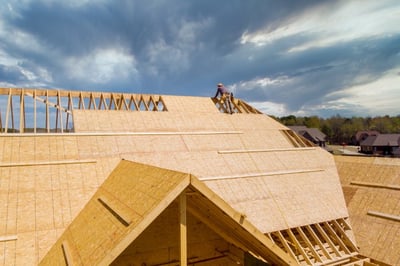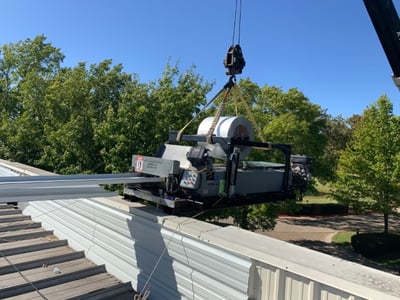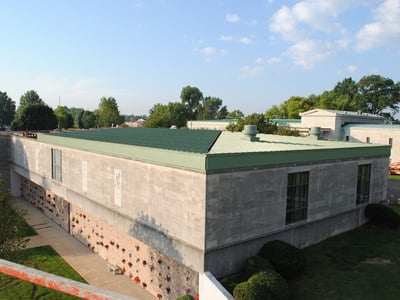How Does the Metal Roof Installation Process Differ from Traditional Roofing Materials?
When you’re talking roofing in the United States, there’s no denying that metal roofing is the new kid on the block, relatively speaking. While we’re seeing exponential growth in the demand for quality, engineered metal roofing systems across the country, many people still think of traditional materials like tile or shingles before they consider metal roof installation for their project.
 Since that is changing, more and more contractors are considering adding metal roof installation to their service list, but it’s common to be a little hesitant.
Since that is changing, more and more contractors are considering adding metal roof installation to their service list, but it’s common to be a little hesitant.
If you’re wondering whether you can tackle metal roof installation with your current crews and equipment, what you’d need to change to expand your roofing repertoire, or just how to install a metal roof versus tile or shingle, you’re in the right place. Here’s what you need to know.
What Stays the Same?
The good news is that many things stay the same for residential/light commercial projects when installing metal roofing compared to shingles. The following concepts in this article do not all apply to larger commercial projects.
You’ll probably still be installing it over a boarded and sheathed roof when you’re doing a residential installation, for instance, and you’ll still need to ensure that your crews have PPE and fall protection for working at heights.
Many modern metal roofing systems are installed with concealed clips, and when they are, you can probably keep using some of your existing screwdrivers and tools.
You’ll also find that while you’re learning how to install a metal roof versus tile or shingle, the principles of flashings and gutters won’t change. So, while you’ll be using pre-formed hips, valleys, apex flashings, and other familiar shapes, they’ll simply be made out of metal that matches your roofing.
What Changes When You’re Installing Metal Roofing?
Installing metal roofing is very similar to installing any other kind of roof in many ways, but some differences might take a little getting used to.
Some of these differences are simply functional, so you just need to change how you tackle metal roof installation projects, but others will require investment in new tools and equipment. We’ve covered that in more detail in a previous post so you can get some idea of the tools and equipment you might need to invest in.
Side to Side Rather Than Bottom to Top Installation
The first big difference you will notice when you are switching to metal roof installation is that for vertical ribbed panel installation, instead of installing your roofing product from the bottom up, you will install your sheets from side to side. On the other hand, some metal tile products are still installed bottom to top, so you will have to familiarize yourself with the new products you’re installing before you start doing take-offs and planning your installation.
Whether you choose concealed clip metal roofing, a mechanically seamed product, or something else, adjacent side-by-side sheets need to overlap vertically at every joint to ensure you have a watertight finished roof. Metal roof sheeting is also usually installed in continuous sheets, so there aren’t any horizontal joints on your roof. However, if you install a metal tile product, you’d still have the familiar horizontal overlaps you’re familiar with.
It can take a little extra metal roof installation planning to ensure that all your sheets overlap and are installed correctly, especially on complex roof projects.
 A Roll On-Site Option
A Roll On-Site Option
One of the biggest pluses of metal roof installation is that some metal roof manufacturing companies offer a roll-on-site option. This means that even if you need very long sheets that are too long to transport on an ordinary flatbed or semi, you can still have continuous sheets that are the exact length you need for your project.
Transportable mills that roll various metal roofing profiles can be delivered to your site, where a skilled operator can roll your roof sheets on demand from your chosen metal coil.
Not only does this make it possible to install metal roofing on nearly any roof, but it also helps to cut your freight and storage costs to nearly zero, which is a huge plus for any roofing contractor.
Roof Lower Pitches
 One of the biggest benefits of metal roofing over other, more traditional roofing materials is that many metal roof profiles are designed to move large amounts of water off the roof very quickly. Most low-pitch applications require a standing seam roof panel that attaches with concealed clips and the use of a motorized seaming machine during installation. Since this type of system is frequently installed without exposed fasteners, there’s even less risk of leaking.
One of the biggest benefits of metal roofing over other, more traditional roofing materials is that many metal roof profiles are designed to move large amounts of water off the roof very quickly. Most low-pitch applications require a standing seam roof panel that attaches with concealed clips and the use of a motorized seaming machine during installation. Since this type of system is frequently installed without exposed fasteners, there’s even less risk of leaking.
Different metal roof profiles are designed for different roof pitches, and some work better than others, so if you’re considering metal roofing, it’s always best to speak to a specialist before you specify a product for lower-pitched roofs.
All of these things combine to make metal roofing perfect for lower-pitched roofs – sometimes only a few degrees – which would be a challenge with other roofing materials.
You Need to Control Sparks
Hot work and cutting on site are always a concern when working on a roofing project, but when installing metal roofing, there’s something other than fire that you need to worry about.
That’s because traditional methods of cutting metal roofing – like angle grinders with cutting discs – tend to create sparks and tiny shards of white-hot metal known as swarf. When this lands on your metal roof sheets, it can damage the coating or paint, and that can lead to premature corrosion in those areas of your roof.
The simple way to avoid this is to use special cold-cutting blades for any on-site cutting you plan to do on a metal roofing project. Ordering roof material in precut lengths to minimize the need for cutting on-site is another good idea, not only to protect your sheets but also to limit offcuts and waste material.
It’s also a good idea to sweep your roof projects at the end of each day so that you can remove any metal filings or debris that may still be on the roof. It’s a small addition to your daily routine that can really have a big impact on your results.
Protecting Color Coatings
While shingles and tiles are not indestructible as far as roof materials go, they generally don’t show scratches and damage too easily.
On the other hand, metal roofing can be scratched and damaged during storage, handling, and installation. Many manufacturers offset this risk by supplying their roofing panels with a protective plastic coating applied, but as long as you handle them carefully, you should be able to avoid serious damage to your metal roofing material on site.
This is important because deep scratches on your metal roofing not only look unappealing but can also increase the risk of premature corrosion in that area. If a manufacturer’s coating warranty covers your roof material, physical damage to the coating system might also affect what that warranty will cover in terms of repairs and replacement for corrosion.
Controlling Runoff and Preventing Galvanic Corrosion
The last big difference you need to be aware of when you’re thinking about making the switch to installing metal roofing is that, unlike other types of roofing, metal roofing can rust. This usually happens when the coating is damaged and the metal substrate is exposed to water and other chemicals.
One big cause of corrosion is something most people don’t think of, and that’s when there’s runoff from a different type of metal onto your metal roof or when you have two different kinds of metal roofs touching each other.
So, for instance, if you have copper butting up to galvanized steel, you might expect to see accelerated corrosion in that area. It’s essential to plan your metal roof installation projects to avoid this kind of galvanic corrosion, and you might need to make some changes to other elements of the roof to protect the metal roof sheets you’re installing.
A Thoroughly Modern Roofing Solution
Even though there are some differences between metal roof installation and traditional roofs, there’s no denying that it’s one of the most exciting roofing materials on the market today.
Not only is metal roofing lightweight and available in a huge variety of profiles, colors, and designs, but many metal roofing products have been proven to last longer. They can even – in some cases – withstand hurricane-strength winds.
More and more homeowners are choosing metal roofing for new builds and re-roofs, and it’s fast becoming a favorite of architects and engineers.
Installing metal roofing is not necessarily more difficult than installing any other kind of roof, although there are a few differences and tricks to learn along the way. But once you learn how to install a metal roof, you will open the door to an enormous range of new roof design options, products, and possibilities.
About McElroy Metal
Since 1963, McElroy Metal has served the construction industry with quality products and excellent customer service. The employee-owned components manufacturer is headquartered in Bossier City, La., and has 14 manufacturing facilities across the United States. Quality, service and performance have been the cornerstone of McElroy Metal’s business philosophy and have contributed to the success of the company through the years. As a preferred service provider, these values will continue to be at the forefront of McElroy Metal’s model along with a strong focus on the customer.




.png?width=767&name=What%20to%20Expect%20When%20You%20Order%20From%20McElroy%20Metal%20(1).png)


.png?width=440&height=293&name=How%20to%20Install%20Metal%20Roofing%20Over%20Existing%20Metal%20Roofs%20(1).png)


Comments on this article:
Scroll down to the bottom to submit a comment and join the conversation. Need help or have a question? Please contact us. Looking for a distributor or contractor? Please click here to get started.